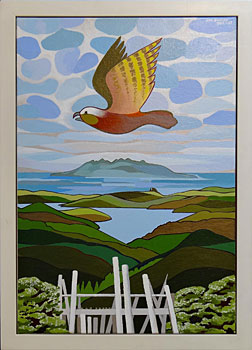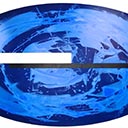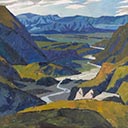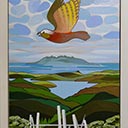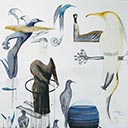Kairara Kaka Variant
66 x 46 cm
est. $110,000 - 140,000
PROVENANCE
Private Collection, Taranaki
Purchased from Fisher Gallery circa 2006
Private Collection, Christchurch
EXHIBITED
BINNEY 1959 - 1989 A Survey. A Retrospective Exhibition of Don Binney's works, 19 August - 17 September 1989 The Fisher Gallery, Pakuranga, Auckland
Don Binney is well known for his clean-edged modernist paintings of birds in the landscapes of New Zealand. In his search for subject, he is inspired by dramatic wilderness areas and environments, which he draws from to express both his passion for painting and his love of ornithology and nature. In an interview with Patricia Sarr and Tom Turner in 1977, Binney described his motivation for painting: I paint and draw because I'm thoroughly committed to and involved with environmental, natural stimuli - the landscape, the wild-life...you must approach the landscape or the bush with reverence.
Binney's earliest paintings were predominately landscapes, the approach of which can be traced to styles found popular in America in the 1930's. This style removes small detail and concentrates on landform and rhythmic curves, Rita Angus, Doris Lusk and William Sutton also took influence from this period. Binney's early works had an abstract feel to them, representing landscape in an almost cubist-style of brushwork. As his work matured, he began to depict birds as the central concern in this paintings, the landscape became more of a backdrop to the main focus.
Eventually though, landscape and birds shared his attentions equally, and he produced many works which talk of New Zealand's environmental concerns and birdlife.
Kairarara Kaka Variant 1982 - 83 is a particularly striking work, painted with thick brushstrokes in a painterly style, in this sense it harks back to earlier pieces by Binney. The paint application is fairly patterned in areas, paint appearing quite viscous and thick, making the work just as captivating close-up as from afar. The structure of the composition allows for several focal points in the work, the eye is first drawn to the bird and then through the landscape to the fence in the fore. This same fence is depicted in a later work by the artist entitled Kaka, 1984, Binney often included architectural structures or monuments which symbolised a human presence in his painting. It is clear here that this is not an ideal land before human intervention, it is New Zealand in the time the artist painted it. This work is an excellent example of Binney's work from this era, portraying the bird, landscape and human elements in the one painting.
From text affixed verso -The Fisher Gallery, Pakuranga

